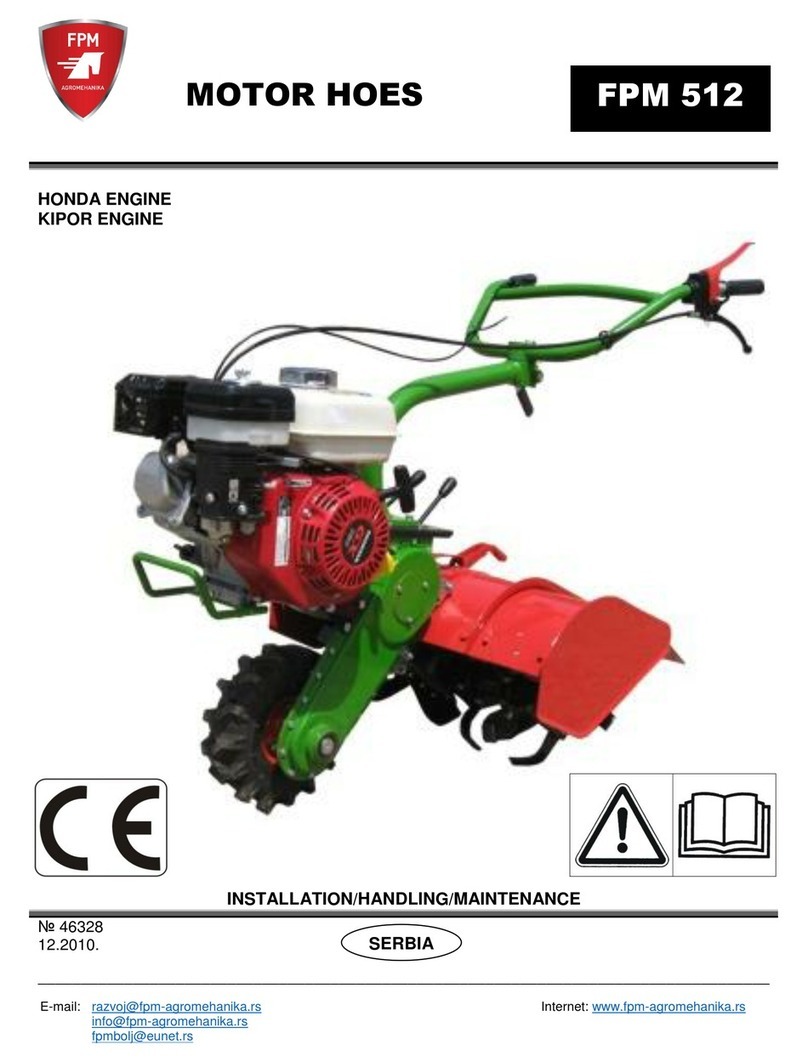
- Persons under the age of 16 shall not be allowed to operate the motocultivator.
- Before starting the engine, make sure that the lever for changing the gear is in
stand by.
- Every time before using the motocultivator, check that all parts (nuts, bolts and other)
are sufficiently tightened.
- All parts that have been damaged, and their elements for fastening (nuts, screws, etc.) in case of
damage must be immediately replaced by the original parts of FPM
Boljevac.
- The working linkage of the motocultivator is attached to the basic machine only to the original
link elements.
- Before starting to adjust, lubricate or clean the drive or connecting parts, stop the motocultivator and
wait for the rotary parts to stop.
- When changing the workplace, and for the shortest distance, it is mandatory to switch off the control
lever drive of a working tool.
- During operation with the rotary mower, the protective sheet must be installed and you can not work
without it.
- You can not clean the mower rotor and knives with your bare hand, but with an object for that purpose.
IMPORTANT: Do not work on stony soil, to avoid the risk of an accident, due to the rejection of
the stone to objects and persons and possible breakage of cutting knives.
- In no case should you work with the rotor, which is not all attached
with anticipated knives. The lack of a certain number of knives on the rotor causes uneven
operation and vibration, which can lead to major damage to the tool.
- When working with the motocultivator on larger lateral slopes, an assistant is needed, who will
use a lever or rope to hold on the machine.
- Only attach the trailer to the motocultivator with the original pin (wedge).
- The brakes on the trailer must be correct.
- In order to easily and safely manage the tractor with a trailer, the pressure of the
tires of the drive wheels will be the same.
- It is mandatory to take into account the prescribed load capacity of the trailer.
- The load in the box of trailers is evenly distributed within the box size.
- The motocultivator aggregated with a trailer can only be driven with the correct steering wheel
and the right braking device.
- It is mandatory to reduce turnaround speed, in order to avoid overturning, especially when
driving with trailer.
- In transport, the slope never drives with the engine off.
- When they require special occasions, indicate lightening danger if not prohibited by traffic
rules.
- Before you start driving on public roads, a tractor with a trailer must be secured for safe
driving, and you should respect the rules of conduct in public transport.
- Do not pour fuel into the tank when the engine is running. Leave the engine cool down about
two minutes before charging.
- Spilled fuel to parts of the engine or motocultivator must be wiped out due to danger from a
fire.
- When pumping fuel into the tank, smoking, ignition of matches, lighters or the like is forbidden.
- If possible, the fuel is filled outdoors or only in well-ventilated areas.
- Do not store or use fuel near an open flame or devices that can cause a spark.
- Do not use the engine without exhaust cistern. Check it periodically and replace if necessary.
- Do not touch the warm exhaust pipe, cylinder or engine ribs, as you can get burns.
- The starter should be pulled firmly to prevent injury to the hand, arm and back.
- After completion of work with the cultivator, an authorized service technician should look at
your machine, bring it to the correct state, especially the engine, and fix all the tightening parts
(screws, nuts and other).




























